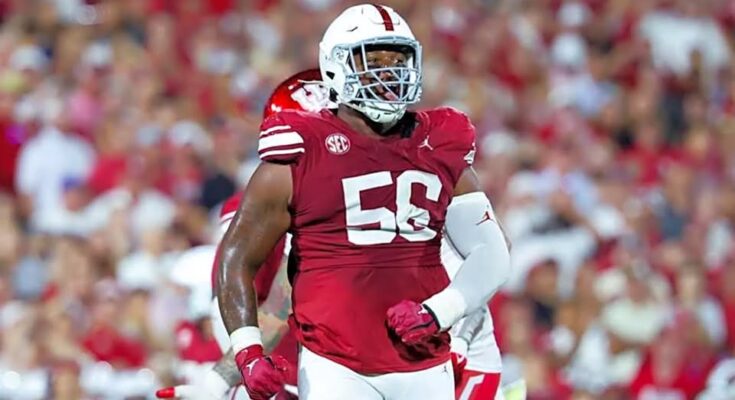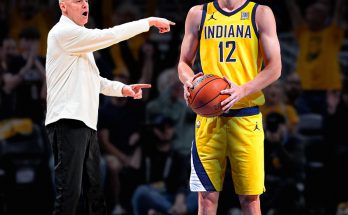Oklahoma Football Prioritizes Building Quality Depth Behind Experienced and Dominant Defensive Tackle Foundation Ahead of the 2025 Season.
Oklahoma football enters the 2025 season with a clear objective on the defensive side of the ball—maximize the potential of its defensive tackle unit while urgently developing depth behind it. Brent Venables and his staff have methodically constructed a formidable front that can disrupt opposing offenses, but to sustain success deep into a grueling SEC schedule, the Sooners must ensure the rotation behind their top-tier tackles is as effective as the starters. This year’s journey is not just about star power—it’s about fortifying the trenches with capable reinforcements who can step up when needed most.
The defensive tackle position has historically been a key pillar in elite college football defenses. For Oklahoma, the situation is no different. The Sooners are built around a strong interior that boasts talent, power, and leadership. Players like Jacob Lacey and Da’Jon Terry provide the kind of veteran experience and physical dominance that allows the rest of the defense to operate freely. These two tackles are expected to anchor Oklahoma’s defensive line, commanding double-teams, stopping the run, and pushing the pocket on passing downs. Lacey, with his refined technique and game IQ, and Terry, a massive interior force with SEC experience, provide a duo that can set the tone up front.
But as talented as the starting group may be, football seasons are rarely defined by the first-string alone. Injuries, fatigue, and the demands of facing elite offensive lines week after week in the SEC necessitate a deeper rotation. That’s where the focus of the coaching staff has shifted in the offseason. It’s not enough to have two or three reliable tackles—the Sooners need six or more players they can trust to rotate in and maintain the intensity and disruption in the trenches.
That task begins with player development and identifying the right young contributors. Redshirt freshmen and true sophomores will be crucial to building that depth. Players like Ashton Sanders and Gracen Halton are seen as high-upside talents who now face the challenge of consistency. Sanders has shown flashes in limited action—burst off the snap and a relentless motor that could translate into a real contributor if he can master technique and gap responsibility. Halton, meanwhile, possesses raw power and athleticism that the staff believes can be harnessed into a disruptive force on the interior.
The transfer portal has also provided Oklahoma with reinforcements, a trend that reflects the modern landscape of college football. The coaching staff was proactive in targeting linemen who could fill rotational roles and compete for snaps right away. While some transfers may not have had major roles at their previous schools, their experience and physical maturity are valuable assets when building a reliable depth chart. The ability to plug in a redshirt junior with two years in a Power Five strength program is often more valuable than relying solely on true freshmen.
Speaking of freshmen, Oklahoma’s 2025 recruiting class also brings intriguing possibilities. While most true freshmen defensive tackles need a year to acclimate physically and mentally, elite talents can sometimes break that mold. Incoming freshmen such as Marcus Strong and Elijah Campbell have drawn early praise during spring workouts for their attitude and work ethic. Though they may not see extensive snaps early in the season, both are considered long-term answers at the position and could find their way into the rotation by midseason if they continue progressing.
Spring camp and summer conditioning sessions have placed a premium on conditioning and technique, especially for the younger players. Defensive tackles coach Todd Bates has made it clear that discipline, pad level, and leverage are non-negotiable fundamentals. With SEC offenses varying in style—some leaning on power run games, others spreading the field with tempo—the need for well-coached, assignment-sound linemen is more pressing than ever. Bates has pushed his unit hard during drills, emphasizing hand placement, block shedding, and lateral movement.
Leadership also plays a vital role in developing depth. Veterans like Lacey and Terry are expected to mentor the younger players, both on the field and in the film room. Their ability to model preparation, practice habits, and in-game adjustments will influence how quickly the second and third groups can mature into viable contributors. This culture of accountability and learning from within has been a hallmark of Venables-led defenses in the past, and Oklahoma aims to replicate that standard this season.
Another key factor is schematic flexibility. Oklahoma’s defense may operate out of multiple fronts, requiring players to adapt to different alignments and responsibilities. Some tackles may find themselves shaded over the center in odd fronts, while others must play the 3-technique in four-man fronts. This versatility places added importance on football IQ and film study. Coaches are evaluating not just physical tools, but mental processing and the ability to execute different assignments from week to week. Those who prove adaptable will earn more opportunities.
As Oklahoma prepares for early tests in its 2025 schedule, including matchups with physical teams like LSU and Florida, the need for depth will be tested immediately. These games will provide insight into which players can handle the speed and physicality of top-tier competition. If the backups can hold their own when the starters need a breather, Oklahoma’s defensive front could become one of the most complete and durable in the SEC.
Recruiting will also remain a factor throughout the fall and into the early signing period. Oklahoma’s coaching staff is targeting elite defensive tackles in the 2026 class, aiming to keep the pipeline strong for future seasons. The emphasis is clear—the Sooners want to be known not only for producing pass rushers off the edge but also for churning out dominant forces in the middle of the line. That identity begins with depth and continuity, and the coaches are laying the foundation for that now.
Beyond the personnel, there’s an intangible element to building depth—confidence. Coaches must instill belief in young players, and those players must internalize it and play without hesitation. This is especially true at defensive tackle, where mistakes are often punishing. A missed assignment can open massive running lanes or eliminate a pass-rushing opportunity. The margin for error is small, and confidence can be the difference between a reliable rotation and a liability.
Oklahoma’s strength and conditioning staff plays a critical role in this process. The interior line is where stamina meets brute strength, and the staff has focused on increasing explosive power while maintaining the endurance needed for fourth-quarter battles. Players are being challenged to hold their ground against double teams and to explode through gaps late in drives when fatigue sets in. Those who can win these battles consistently will earn the trust of the coaching staff.
There’s a broader picture here, too. If Oklahoma wants to compete for SEC titles and College Football Playoff berths, it must win the line of scrimmage every week. Depth at defensive tackle isn’t just a luxury—it’s a requirement. The best teams rotate their linemen without any drop-off in performance, keeping everyone fresh and aggressive deep into the fourth quarter. Venables knows this from his time at Clemson, where depth and defensive line play were critical to multiple national title runs. He’s brought that philosophy to Norman, and now it’s time for the younger Sooners to rise to the occasion.
The 2025 season offers both opportunity and challenge for Oklahoma. With stars like Lacey and Terry providing a strong base, the blueprint is in place. Now it’s up to the coaching staff to cultivate the next wave of defensive tackles who will provide the continuity and reliability needed to compete at the highest level. Every snap in fall camp, every rep in the weight room, and every second in the film room matters.
By the time September arrives, the Sooners hope to have more than just a dominant starting duo. They want a full rotation of defensive tackles who can take over games, rotate in seamlessly, and help Oklahoma’s defense evolve from good to elite. If that vision becomes reality, it could be one of the key reasons Oklahoma emerges as a legitimate threat to contend in the SEC and on the national stage. The path to that goal runs through the trenches, and depth behind the defensive tackle foundation may well decide just how far the Sooners can go.



